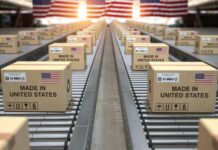With more tariffs on electric vehicles and an election featuring two pro-tariff presidential candidates on the way, the debate about how best to support and strengthen the U.S. manufacturing sector is back. Some argue, mistakenly, that the key to protecting American industries and manufacturing jobs is a set of tariffs on industrial imports. This approach is ultimately counterproductive. There are better ways to help American manufacturing, not the least of which is to remove regulatory barriers and reform the tax code.
U.S. tariffs — taxes on Americans’ purchases of imports — are touted as a means of “leveling the playing field” by protecting domestic manufacturers from foreign competition.
But this view overlooks the fact that tariffs raise costs not only for consumers but also for American businesses that use imports as inputs. Further, tariffs disrupt supply chains and cause trading partners to impose retaliatory tariffs on our exports.
Even more significantly, tariffs do little to address the underlying factors that make it difficult for U.S. manufacturers to compete in the global marketplace. Instead, manufacturers need a more favorable regulatory and tax environment. It should be obvious that excessive regulations place significant burdens on businesses, increasing compliance costs, stifling innovation and making it harder for companies to adapt to changing market conditions.
And boy, does manufacturing suffer from excessive regulations. From environmental regulations like the National Environmental Policy Act to labor regulations like the Occupational Safety and Health Act to consumer protection and product safety regulations to financial and accounting regulations like the Sarbanes-Oxley Act, manufacturers in America face an unnecessarily onerous burden.
In a recent paper titled “Industrial Headwinds: Reducing the Burden of Regulations on U.S. Manufacturers,” published in the May 2024 Club for Growth Policy Handbook, economist Daniel Ikenson writes, “For manufacturing firms, the cost of federal regulations in 2022 was roughly $350 billion, or 13.5% of the sector’s GDP — a burden 26% greater than the inflation-adjusted cost of regulatory compliance in 2012.”
He adds that while the average U.S. company pays a regulatory compliance price of $13,000 per employee, large manufacturers shoulder a cost more than twice as much — $29,100. However, even some small-sized manufacturers face annual compliance costs of $50,100 per employee. This helps explain why manufacturing automation is so popular and why our fastest-growing companies are in service-sector tech, not manufacturing.
One wonders how small manufacturers even stay in business.
And yet, this much is sure: U.S. manufactures are still successful. This is remarkable given that they’re so heavily encumbered by government regulations. Ikenson reminds us that “despite the varied accumulating impositions thrust upon US manufacturers … in 2022, ‘real manufacturing GDP’ reached a record high of $2.28 billion. Sector value added per worker also reached a record high of nearly $142,000, which was 50% more than South Korea, who landed second for that metric.”
Imagine America’s industrial might with streamlined, simplified regulations. While still maintaining necessary protections for workers, consumers and the environment, the government can reduce the barriers to entry and growth for manufacturers. Many states have taken real steps in this direction.
In addition, making the tax code simpler and more transparent would provide a significant boost to manufacturing. In her chapter of the handbook, the Tax Foundation’s Erica York explains that our tax code is punishing capital-intensive sectors like manufacturing. Capital investments, such as machinery and equipment, are subject to overly long depreciation schedules for tax purposes. These schedules often require businesses to deduct the cost of these investments over an extended period, which can be much longer than the useful life of the assets. The result is that manufacturers might not be able to fully recover the cost of their investments in a timely manner, tying up capital that could otherwise be used for growth or innovation.
The U.S. tax code often puts domestic manufacturers at a disadvantage compared to their foreign counterparts. Some countries, including China, offer more favorable tax treatment for capital investments, such as faster depreciation schedules or more generous expensing provisions, which make it more attractive for companies to invest in those jurisdictions. By lowering corporate tax rates, allowing for full and immediate expensing of capital investments, and reducing the tax burden, the government can encourage economic growth. Tariffs only hamper such efforts.
Instead of erecting barriers to trade, policymakers should focus on creating an environment more conducive for manufacturing growth and competitiveness. This is where America’s been falling behind. It’s time we do more about it.































